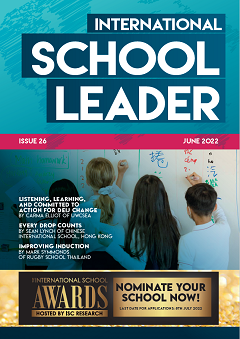By Kamal Bodhanker
In recent years, diversity, equity, inclusion and justice (DEIJ) has risen to the fore of the international school agenda. The scope of focus is broad, from examining DEIJ as employers to enabling it as educators. However unique these areas may seem operationally, the key to progress is the same – developing a culture of inclusion. Increasingly, inclusion is not a separate agenda for certain groups; inclusion requires forms of exclusion and marginalisation to be considered holistically.
What do we already know about inclusion?
Concerning children and young people with special educational needs, disabilities and learning differences (SEND), there have been a range of landmark international documents. They have all sought to do similar things in terms of putting forward a global agenda for a more inclusive society. Potentially one of the most well-known is the Salamanca statement of 1994, which was a commitment to adopt the principle of inclusion as a matter of law or policy, trying to move some of the rhetoric into reality. Inclusive education is further enshrined within later international agreements, particularly the UN Convention on the Rights of Persons with Disabilities and the UN Convention on the Rights of the Child.
All of those agreements have similar threads running through them, clearly stating that children and adults with disabilities, and their families, have the same right to a high-quality appropriate education as everyone else. They seek to give people with special educational needs and/or disabilities a sense of agency or control so that rather than education being done to or for them, it is done with them, in partnership. Education that is felt to be appropriate for them is giving children, young people and their families the right to choose and receive an education in an inclusive environment as opposed to being siloed somewhere outside the rest of the community. They promote the right to the support that they might need, including resources and expertise that can meet educational therapeutic or broader citizenship needs. The idea here is that once this happens on an educational level it will translate to citizen level as well.
What is a culture of inclusion?
As school leaders, developing culture is an area of expertise. Schools boast of having a supportive culture, an innovative culture, a collaborative culture. So how is creating an inclusive culture any different? It begins with asking ourselves how committed we are to inclusion… and answering, honestly.
The ISC Research 2020 report Inclusion in International Schools identified that, compared to previous research conducted in 2017, more international schools reported themselves to be at the beginning of the journey towards inclusion, more schools recognised the wider social, emotional and mental health conditions of their pupils, and more schools served students who require a learning specialist in the mainstream classroom. Yet, concerningly, only 28% of international schools involved in the study reported that it is true that teachers in their school feel responsible for the education of children with special educational needs. This narrative highlights that addressing the gap between institutional visions for inclusion, and the attitudes and beliefs of educators is a priority area for development and a key milestone in building an inclusive culture.
How can education be more inclusive?
There has been a lot of work trying to unpick how we can make education more inclusive. It is often referred to as a wicked problem because it requires change on multiple levels – both at a legislative level and a personal level, such as the attitudes of educators.
The first step towards being inclusive is thinking, talking, reviewing and refining practice; to do that there needs to be a catalyst for change. There needs to be a drive to want to do it.
A central aspect of classroom practice in inclusive schools is flexibility. Flexibility to be able to adapt to the inherent variability of all children.
With this comes the responsibility to proactively design learning environments, adapted to meet such variance.
One consistent factor is a culture that views student diversity positively – one which looks to positively embrace having diverse ways of thinking within their settings.
So, what’s new here? Nothing. These are features that are found in good schools and classrooms everywhere. If we know what is needed and what works, what’s the big deal? The question remains: how do schools strategically embed inclusion, diversity, equity and justice in a sustainable way?
Where do we start on a school’s road to inclusion?
Nasen’s road to inclusion, inspired by the recommendations of the global education monitoring 2020 report All Means All, outlines the multiple priority areas and actions for everyone involved in education, from teachers to policymakers.
Learn about inclusion practice from peers
A key landmark on the road to inclusion is to learn from the success of others. This year’s shortlisted nominees for the International School Award for Diversity, Equity, Inclusion and Justice were trailblazers in their own rights. Each nominated school showed brave and responsive leadership; some enabled the student body to shape the school’s inclusive culture by responding to calls for action from the student body. The winner, Brighton College, Bangkok, focused on building an agile and supportive programme of remote learning for pupils with additional educational needs. The unifying factor of each of these successful examples were that they were driven by the school’s senior leaders, as part of a desire to improve the school’s culture.
The magic formula to inclusion and school improvement
Recognising that inclusion improves the school is the first key step. There is no magic formula to school improvement, the process is iterative and fraught with change. However, a strategic focus on the following will make a meaningful difference:
- widening understanding of inclusion
- empowering the workforce
- collecting and responding to data on inclusion
- applying universal design
- challenging and filling gaps
- sharing expertise and resources
- targeting those left behind
- learning from peers
- engaging in meaningful consultation
- co-producing with parents
Key takeaways for inclusion progress
- In recognition that inclusion requires all forms of exclusion, marginalisation, and individual difference to be addressed, school stakeholders need a shared understanding of the school’s vision for inclusion.
- Recognising and respecting the magnitude and significance of equality, diversity inclusion and justice will help stage the strategy.
- The graduated response for SEND can be used far more widely than for pupil provision: assess, plan, do and review apply to your school’s DEIJ strategy.
- Ensure that the right questions are being asked from the outset: Are we doing the right thing? Are we doing it in the right way? Are there better ways of achieving our desired results?

Kamal Bodhanker is Head of International Development at nasen (National Association of Special Educational Needs), a UK-based charitable organisation to support and champion those working with, and for, children and young people with special educational needs, disabilities and learning differences. International membership gives access to many resources. Connect directly with Kamal on LinkedIn.

